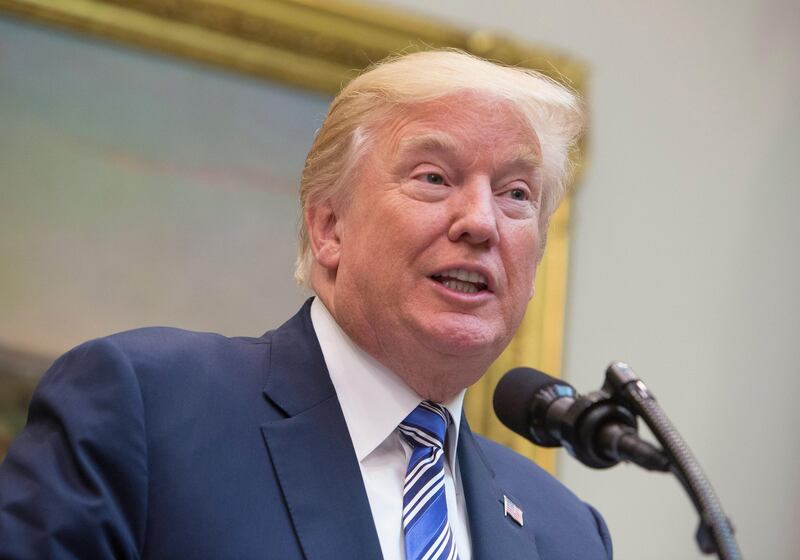US president Donald Trump’s latest salvo in the “fake news” wars, a 90-second video clip highlighting the achievements of his administration, has been panned by critics and picked over by fact checkers.
But at the same time, analysts point out it is part of a growing trend among political leaders seeking ways to bypass the traditional media and reach voters directly.
The 90-second video is hosted by Kayleigh McEnany, until recently a pro-Trump analyst who appeared regularly on CNN.
“Thank you for joining us as we provide the news of the week from Trump Tower here in New York,” she begins.
“More great economic news on Friday: The July jobs report added a better-than-expected 209,000 jobs. Overall, since the president took office, president Trump has created more than one million jobs.”
There follows a round-up of the president’s activities, from introducing an immigration bill to presenting medals to valiant warriors.
“I’m Kayleigh McEnany, and that is the real news,” is her sign off.
Read more: Speculation over 2020 presidential candidates irks White House
In a divided United States, where the White House accuses the media of being obsessed with the ongoing Russia investigation and divisions in the administration, supporters say the new video is a vital tool in getting the president’s message out to the country.
But sceptics quickly weighed in after the "News of the Week" video — apparently the first in a regular series — debuted on Mr Trump’s Facebook page on Sunday.
“Wow. Feels eerily like so many state-owned channels I've watched in other countries,” is how former US ambassador to Moscow Michael McFaul put it.
Conservatives were equally horrified.
“The problem is, when the president spends half his day slamming the media, then employs others to get in front of a camera to not just tout his record, but to call it ‘real’ news, suggesting anything outside of the echo chamber is illegitimate,” wrote Susan Wright for the conservative RedState blog.
“That’s propaganda straight out of North Korea’s playbook.”
Evan McMullin, who ran against Mr Trump as an independent candidate in last year's presidential election, wrote on Twitter: “This is the type of propaganda you’d see in North Korea. It erodes the people’s ability to discern truth and hold government accountable.”
And Seth Meyers, a comedian and satirist, described it as state news crossed with a school broadcast.
The video is not the first time Mr Trump’s team has broadcast content directly to viewers.
The president’s daughter-in-law, Lara Trump, wife of Eric, anchored a similar video last month listing Mr Trump’s achievements.
“I bet you haven’t heard about all the accomplishments the president had this week because there is so much fake news out there,” is how she began.
She is also reported to be behind the latest "News of the Week" productions, which are to be filmed in a new studio at Trump Tower in New York and paid out of Trump campaign funds.
The president's former — and short-lived — communications director Anthony Scaramucci had a plan for a morning television show filmed from a desk on the White House lawn to better spread Mr Trump's message. In the end he didn't last long enough in the role to put the idea into practice.
Read more: Long list of candidates for Trump to fill in Scaramucci and homeland security posts
Jeanne Zaino, professor of political science at New York state’s Iona College, said such an approach made perfect sense for a president whose ratings were at historic lows to appeal to his shrinking base of support.
“I don’t see this as anything but a very old-fashioned attempt to go around the press and speak to people directly,” she said.
“It costs very little money and very little time to get his message out.
“You can quibble about whether it is factually accurate — was he responsible for the jobs? Probably not. But everybody puts out talking points and this is just another way of doing that.”
The strategy has been used by both sides amid an increasingly polarised media landscape.
Former US president Barack Obama received frequent criticism for using social media — such as being interviewed by YouTube stars or holding town hall-style meeting on Twitter — which opponents saw as a soft option.
Meanwhile, Andrew Cuomo, elected governor of New York in 2010, was condemned for refusing all interview requests, except for a sit-down with the magazine GQ.
Mr Trump faces a particularly acute problem, however.
After 200 days in office, his approval rating has dropped to only 38 per cent, according to a CNN poll published on Tuesday, and there are signs that even his most committed supporters are cooling in their feelings towards him.
Video newscasts will help stoke the base but have little impact on Mr Trump’s opponents, according to Prof Zaino.
“This is designed to help drum up support among his base,” she said. “It would be very far fetched to imagine that people opposed to him will listen to these videos and change their mind about Donald Trump.”






